Text
Significance Of Coral Reefs In Tropical Marine Ecosystem

Credit: Georgette Douwma via Getty
Welcome to the last entry of the blog series about coral reefs. This blog talks about the significance of coral reefs in tropical marine ecosystems. For instance:
Habitat
Food source
Coastal protection
Habitat
Coral reefs are direct habitats for many taxa. They are also the refuge of some species (e.g., small fishes) against predators (Friedlander & Parrish 1998; Kerry & Bellwood 2012). The variation in morphology and shape of each colony contributes to the structural complexity of coral reef habitats (Richardson Graham & Hoey 2017), which are suitable for diverse marine species to thrive in and reproduce. In the world, coral reefs occupy less than 0.1% of the ocean floor, but they provide habitat for more than 25% of discovered marine creatures (Fisher et al. 2015). One-third of global marine fish biodiversity is harboured in coral reefs (Spalding & Grenfell 1997). The video shows diverse marine creatures living in coral reefs.
youtube
Credit: California Academy of Sciences
Food source
Coral reefs are the food source of some species (Hoegh-Guldberg 2011), such as the coral-feeding fish and flamingo tongue snail. Based on the feeding preference, the coral-feeding species feed on the coral polyps, coral mucous, live and dead coral skeletons (Cole, Pratchett & Jones 2008). Some species almost feed exclusively on corals, with more than 80% of the diet being corals (Cole, Pratchett & Jones 2008). These species, called obligate corallivores, are, therefore, highly dependent on corals as food for survival (Pratchett et al. 2008). Regarding fish species, most obligate coral-feeding fishes come from the family Chaetodontidae, which was mentioned in the 4th entry of the coral reef blog series (Cole, Pratchett & Jones 2008). In contrast, facultative corallivores also feed on corals, but corals only occupy a part of their diet. The video shows some fish eating the corals.
youtube
Credit: World Economic Forum
Coastal protection
Coral reefs can protect coastal property and life against floods and waves due to rising sea levels by acting as natural wave barriers (Monismith et al. 2015; Hearn 1999). The complex structure of living coral reefs dissipates the wave energy. The dissipation results from the high friction on the high hydraulic roughness of reef structures and wave breaking on the reef rim (Monismith et al. 2015; Hearn 1999; Rogers et al. 2016; Lowe et al. 2005). The structurally complex coral reefs are significant in preventing the formation of larger waves because these waves can cause coastal erosion at the near-shore zones of beaches and tropical reef islands (Quataert et al. 2015; Baldock et al. 2014). The video talks about the role of coral reefs in protecting coastlines and the consequences if they degrade.
youtube
Credit: USGS
That's all about the significance of coral reefs in tropical marine ecosystems. Of course, besides the three mentioned significance, coral reefs also have other importance. Now, we have reached the end of the blog as well as the end of the coral reef blog series. You have completed the journey of exploring coral reefs. I hope you learn something nice from this blog series. Thank you.
References
Baldock, TE, Golshani, A, Callaghan, DP, Saunders, MI & Mumby, PJ 2014, ‘Impact of sea-level rise and coral mortality on the wave dynamics and wave forces on barrier reefs’, Marine Pollution Bulletin, vol. 83, no. 1, pp. 155-164.
Cole, AJ, Pratchett, MS & Jones, GP 2008, ‘Diversity and functional importance of coral‐feeding fishes on tropical coral reefs’, Fish and Fisheries, vol. 9, no. 3, pp. 286-307.
Fisher, R, O’Leary, RA, Low-Choy, S, Mengersen, K, Knowlton, N, Brainard, RE & Caley, MJ 2015, ‘Species richness on coral reefs and the pursuit of convergent global estimates’, Current Biology, vol. 25, no. 4, pp. 500-505.
Friedlander, AM & Parrish, JD 1998, ‘Habitat characteristics affecting fish assemblages on a Hawaiian coral reef’, Journal of Experimental Marine Biology and Ecology, vol. 224, no. 1, pp. 1-30.
Hearn, CJ 1999, ‘Wave‐breaking hydrodynamics within coral reef systems and the effect of changing relative sea level’, Journal of Geophysical Research: Oceans, vol. 104, no. C12, pp. 30007-30019.
Hoegh-Guldberg, O 2011, ‘Coral reef ecosystems and anthropogenic climate change’, Regional Environmental Change, vol. 11, pp. 215-227.
Kerry, JT & Bellwood, DR 2012, The effect of coral morphology on shelter selection by coral reef fishes’, Coral Reefs, vol. 31, pp. 415-424.
Lowe, RJ, Falter, JL, Bandet, MD, Pawlak, G, Atkinson, MJ, Monismith, SG & Koseff, JR 2005, ‘Spectral wave dissipation over a barrier reef’, Journal of Geophysical Research: Oceans, vol. 110, no. C4.
Monismith, SG, Rogers, JS, Koweek, D & Dunbar, RB 2015, ‘Frictional wave dissipation on a remarkably rough reef’, Geophysical Research Letters, vol. 42, no. 10, pp. 4063-4071.
Pratchett, MS, Munday, P, Wilson, SK, Graham, NA, Cinner, JE, Bellwood, DR, Jones, GP, Polunin, NV & McClanahan, TR 2008, ‘Effects of climate-induced coral bleaching on coral-reef fishes’, Ecological and Economic Consequences. Oceanography and Marine Biology: Annual Review, vol. 46, pp. 251-296.
Quataert, E, Storlazzi, C, Van Rooijen, A, Cheriton, O & Van Dongeren, A 2015, ‘The influence of coral reefs and climate change on wave‐driven flooding of tropical coastlines’, Geophysical Research Letters, vol. 42, no. 15, pp. 6407-6415.
Richardson, LE, Graham, NA & Hoey, AS 2017, ‘Cross-scale habitat structure driven by coral species composition on tropical reefs’, Scientific Reports, vol. 7, no. 1, p. 7557.
Rogers, JS, Monismith, SG, Koweek, DA & Dunbar, RB 2016, ‘Wave dynamics of a Pacific Atoll with high frictional effects’, Journal of Geophysical Research: Oceans, vol. 121, no. 1, pp. 350-367.
Spalding, MD & Grenfell, AM 1997, ‘New estimates of global and regional coral reef areas’, Coral Reefs, vol. 16, pp. 225-230.
Images or videos from external sources:
California Academy of Sciences - https://www.youtube.com/watch?v=thbXWo_64V4
Georgette Douwma via Getty - https://www.outsideonline.com/outdoor-adventure/environment/why-your-next-outdoor-adventure-should-be-to-a-coral-reef/
USGS - https://www.youtube.com/watch?v=ut9EW6au85M
World Economic Forum - https://www.youtube.com/watch?v=0OD1hHE5TsM
0 notes
Text
Marine creatures in coral reef ecosystem

Credit: Raavya Bhattacharyya
Hi. This is the fourth entry in the series of blogs about coral reefs. In this blog, we will look at the various fantastic marine creatures in the coral reef ecosystem. More than thousands of marine life interact with coral reefs, but we will only see some of them in the blog. Let's start exploring them.
Coral-feeding fishes
In addition to shelter and living spaces, corals are the food source of coral-feeding fishes (also known as corallivorous fishes) (Cole, Pratchett & Jones 2008). Among 128 corallivorous fishes from 11 families documented, 69 belong to the family Chaetodontidae. Other families include the Balistidae, Labridae, Monacanthidae, Pomacentridae, Scaridae and Tetraodontidae. Below are examples of fish species of the mentioned families. Some are not coral-feeding fishes. The pictures just show how the species will look in a particular family.
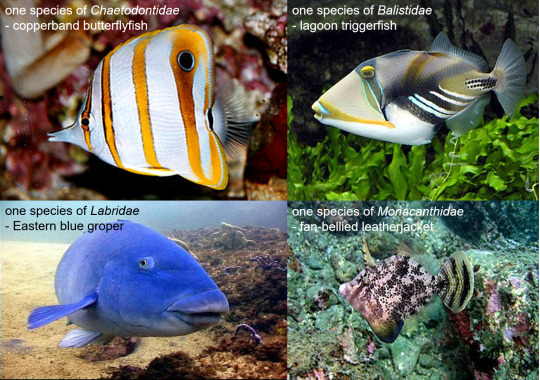

Credit: Wiktionary (Chaetodontidae); Wikipedia (Balistidae; Monacanthidae; Pomacentridae; Scaridae; Tetraodontidae); Tim Hochgrebe (Labridae).
One-third of them almost feed only on corals, which make up more than 80% of the diet. Regarding feeding preference, some ingest the live coral tissue (e.g., coral polyps, coral mucous, coral skeleton), while some prefer the dead tissue (e.g., dead coral skeletons). For instance (Cole, Pratchett & Jones 2008):
coral polyps - chevron butterflyfish, Chaetodon trifascialis, Chaetodontidae
coral mucous - ornate butterflyfish, Chaetodon ornatissimus, Chaetodontidae
live coral skeletons - guieneafowl puffer, Arothron meleagris, Tetraodontidae
dead coral skeletons - scraping scarids

Credit: Francois Libert (chevron butterflyfish); Jim Nelson (ornate butterflyfish); Charlotte B (guieneafowl puffer); One People One Reef (scraping scarids)
This chronic predation can help regulate the abundance, distribution and fitness of some coral prey (Cox 1986; Rotjan & Lewis 2005; Rotjan et al. 2006). For instance, the selective predation of the coral-feeding fish Chaetodon unimaculatus on the corals Montipora verrucosa affects the coral growth, zonation and competitive ability (Cox 1986).
Coral groupers and trouts and their hunting partners
Coral groupers Plectropomus pessuliferus marisrubri and coral trouts Plectropomus leopardus feed on small fishes in the coral reefs (Vail, Manica & Bshary 2013). However, due to their relatively large body size, they cannot enter the coral reefs to conduct predation. Therefore, they cooperate with the hunting partners (Vail, Manica & Bshary 2013). For instance, the coral groupers Plectropomus pessuliferus marisrubri partner with the giant moray eel Gymnothorax javanicus and the Napoleon wrasse Cheilinus undulatus in predation (Bshary et al. 2006). The coral trouts Plectropomus leopardus hunt collaboratively with the octopus Octopus cyanea (Vail, Manica & Bshary 2013). The hunting partnership is beneficial as it increases the predation rate.
Collaborative hunting tactics (Bshary et al. 2006; Vail, Manica & Bshary 2013):
Coral groupers and trouts - indicate location of hidden prey in coral reefs to hunting partners and capture chased prey in open water using burst speed
Hunting partners:
Giant moray eels - have slender body to enter the coral crevices
Napoleon wrasses - have protractile jaws to suck out hidden prey or smash the reef matrix around the prey
Octopuses - have long arms to capture prey in cervices


Credit: Georgette Douwma (Plectropomus pessuliferus marisrubri); Graham Edgar (Plectropomus leopardus); Luis Pérez Berrocal (Gymnothorax javanicus); Giuseppe Mazza (Cheilinus undulatus); Age Fotostock/Alamy Stock Photo (Octopus cyanea )
Flamingo tongue snail
Flamingo tongue snails (Cyphoma gibbosum) are gregarious sea snails that are found on the gorgonian corals, which possess distasteful toxins to protect them from being eaten (Whalen 2008). These tiny creatures are smaller than a postage stamp. Unlike most marine animals, they like to eat the gorgonian corals. They munch the toxin-saturated tissue until the hard skeleton of gorgonian corals using radula (modified tooth). One unique feature is that they can exploit the gorgonian toxins and incorporate them into the flaps of their brightly coloured mantle to make them awful to be eaten by fish (Whalen 2008).
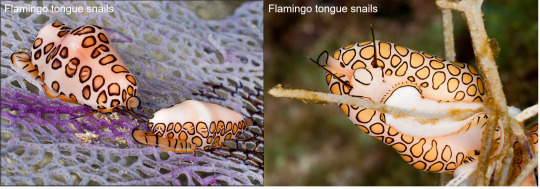
Credit: Linda Ianniello
This is the end of this blog. I hope these fantastic marine creatures in the coral reef ecosystem have amazed you.
References
Bshary, R, Hohner, A, Ait-el-Djoudi, K & Fricke, H 2006, ‘Interspecific communicative and coordinated hunting between groupers and giant moray eels in the Red Sea’, PLoS Biology, vol. 4, no. 12, p. e431.
Cole, AJ, Pratchett, MS & Jones, GP 2008, ‘Diversity and functional importance of coral‐feeding fishes on tropical coral reefs’, Fish and Fisheries, vol. 9, no. 3, pp. 286-307.
Cox, EF 1986, ‘The effects of a selective corallivore on growth rates and competition for space between two species of Hawaiian corals’, Journal of Experimental Marine Biology and Ecology, vol. 101, no. 2, pp. 161-174.
Rotjan, RD, Dimond, JL, Thornhill, DJ, Leichter, JJ, Helmuth, B, Kemp, DW & Lewis, SM 2006, ‘Chronic parrotfish grazing impedes coral recovery after bleaching’, Coral Reefs, vol. 25, pp. 361-368.
Rotjan, RD & Lewis, SM 2005, ‘Selective predation by parrotfishes on the reef coral Porites astreoides’, Marine Ecology Progress Series, vol. 305, pp. 193-201.
Vail, AL, Manica, A & Bshary, R 2013, ‘Referential gestures in fish collaborative hunting’, Nature Communications, vol. 4, no. 1, p. 1765.
Whalen, K 2008, ‘Biochemical warfare on coral reefs’, Oceanus, vol. 47, no. 1, p. 13.
Images or videos from external sources:
Age Fotostock/Alamy Stock Photo - https://www.worldwildlife.org/magazine/issues/spring-2019/articles/meet-the-master-of-camouflage-the-day-octopus
Charlotte B - https://stock.adobe.com/images/golden-guineafowl-puffer-fish-swimming-over-the-bottom-a-funny-and-venomous-tropical-fish-from-the-pacific-ocean/237039937
Francois Libert - https://uk.inaturalist.org/photos/171100563
Georgette Douwma - https://www.naturepl.com/stock-photo/red-sea-coral-grouper-%28plectropomus-pessuliferus-marisrubri%29-egypt-red-sea/search/detail-0_01448718.html
Giuseppe Mazza - https://www.monaconatureencyclopedia.com/cheilinus-undulatus/?lang=en
Graham Edgar - https://reeflifesurvey.com/species/plectropomus-leopardus/
Jim Nelson - https://www.projectnoah.org/spottings/2050146002
Linda Ianniello
- https://www.jaxshells.org/ryxx.htm
- https://www.jaxshells.org/6016.htm
Luis Pérez Berrocal - https://www.inaturalist.org/taxa/121000-Gymnothorax-javanicus
One People One Reef - https://onepeopleonereef.org/resources/fish-info/herbivorous-fishes/parrotfishes-scarids/
Raavya Bhattacharyya - https://travel.earth/best-coral-reefs-across-the-world/
Tim Hochgrebe - https://australian.museum/learn/animals/fishes/labridae-wrasses/
Wikipedia
- https://en.wikipedia.org/wiki/Filefish
- https://en.wikipedia.org/wiki/Parrotfish
- https://en.wikipedia.org/wiki/Pomacentridae
- https://en.wikipedia.org/wiki/Tetraodontidae
- https://en.wikipedia.org/wiki/Triggerfish
Wiktionary - https://en.wiktionary.org/wiki/butterflyfish
1 note
·
View note
Text
How do corals eat and reproduce?
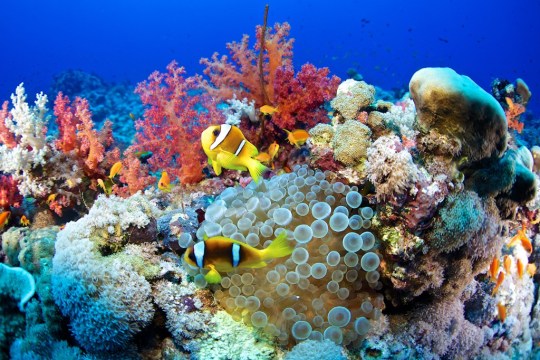
Credit: Vincent Pommeyrol
Feeding behaviour
Most corals are colonial and composed of numerous individual animals called polyps (National Ocean Service 2023). A coral polyp resembles a contractile sac (Goreau, Goreau & Goreau 1979). Each has a stomach, which only opens at one end (National Ocean Service 2023). Both the entry of food and release of waste products pass through the same mouth-like opening of the stomach. The opening is surrounded by a ring of tentacles, which contain the specialized stinging cells called nematocysts (Goreau, Goreau & Goreau 1979).
Corals feed at night (National Ocean Service 2023). They use nematocysts to capture prey. Nematocysts will discharge like arrow barbs and stun the prey with toxins, which are often lethal (Goreau, Goreau & Goreau 1979; National Ocean Service 2023). The size of prey varies, from microscopic animals (e.g., zooplankton, crustacean) to small fish, depending on the size of coral polyps (Goreau, Goreau & Goreau 1979; National Ocean Service 2023). Besides the tentacles, corals also use the mucous film and strands to collect tiny organic particles and draw them into the mouth (National Ocean Service 2023). They also obtain photosynthetic energy from their endosymbiotic dinoflagellates or zooplankton.

This is a coral polyp. Thousands or more of coral polyps together form corals.
Credit: National Ocean Service
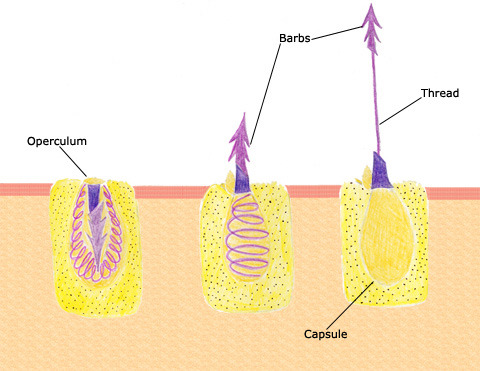
This is a nematocyst cell used by coral polyps to capture prey.
Credit: National Ocean Service
I also found an interesting video showing how coral polyps obtain energy and capture prey:
youtube
Credit: Khaled bin Sultan Living Oceans Foundation
Reproduction
Corals can reproduce asexually and sexually. Asexual reproduction increases the colony size, while sexual reproduction increases the genetic diversity. In asexual reproduction, coral polyps produce genetically identical offspring through budding and fragmentation. Asexual budding is performed by all corals (Jackson 1977). However, fragmentation is mainly performed by branching species (Tunnicliffe 1981; Highsmith 1982; Lirman 2000) because the branching morphology makes it easier to form fragments due to disturbances like waves caused by storms and hurricanes and collision from objects (e.g., marine creatures, fishing equipment). The fragments will re-attach to the substrate and grow into a new colony.
A video demonstrating the asexual budding and fragmentation of corals:
youtube
Credit: MarinePhage
In sexual reproduction, corals produce and release free-swimming larvae into the surroundings (Goreau, Goreau & Goreau 1979). They can be female, male or both (The Ocean Portal Team 2018). The sexual reproduction of corals has two types: brooding (internal) or broadcast spawning (external).In the former, the eggs fertilize and the larvae develop within the parental coral polyps (Harrison 2011). Once released, the larvae settle shortly on the substrate and grow. In the latter, gametes are released into the surrounding water once a year. The fertilization and development of larvae occur outside the coral polyps. Before settling, the larvae will disperse for days to weeks.
The two videos show the sexual reproduction of corals: brooding (first) and broadcast spawning (second):
youtube
Credit: Putnam Lab Productions
Credit: National Ocean Service
That's all for today's blog. Hope you enjoy the reading~
Reference
Goreau, TF, Goreau, NI & Goreau, TJ 1979, ‘Corals and coral reefs’, Scientific American, vol. 241, no. 2, pp.124-137.
Harrison, PL 2011, ‘Sexual reproduction of scleractinian corals’, Coral Reefs: An Ecosystem in Transition, pp.59-85.
Highsmith, RC 1982, ‘Reproduction by fragmentation in corals’, Marine Ecology Progress Series, vol. 7, pp. 207–226.
Jackson, JBC 1977, ‘Competition on marine hard substrata: The adaptive significance of solitary and colonial strategies’, American Naturalist, vol. 111, pp. 743–767.
Lirman, D 2000, ‘Fragmentation in the branching coral Acropora palmata (Lamarck): Growth, survivorship, and reproduction of colonies and fragments’, Journal of Experimental Marine Biology and Ecology, vol. 251, pp. 41–57.
National Ocean Service 2023, What are corals?, National Ocean Service, viewed 16 October 2023, <https://oceanservice.noaa.gov/education/tutorial_corals/coral01_intro.html>.
The Ocean Portal Team 2018, Corals and coral reefs, Smithsonian, viewed 16 October 2023, <https://ocean.si.edu/ocean-life/invertebrates/corals-and-coral-reefs#>.
Tunnicliffe, V 1981, ‘Breakage and propagation of the stony coral Acropora cervicornis’, Proceedings of The National Academy of Sciences USA, vol. 78, pp. 2427–2431.
Images or videos from external sources:
Khaled bin Sultan Living Oceans Foundation - https://youtu.be/tZuxZdG6TfM
MarinePhage - https://www.youtube.com/watch?v=jH4Y3Qh5Xqw
National Ocean Service -
(images) https://oceanservice.noaa.gov/education/tutorial_corals/coral01_intro.html
(video) https://oceantoday.noaa.gov/coralspawning/
Putnam Lab Productions - https://www.youtube.com/watch?v=tNsPGZHMZWM&t=48s
Vincent Pommeyrol - https://www.timeforkids.com/k1/explore-a-coral-reef/
1 note
·
View note
Text
Coral Morphology & Colouration
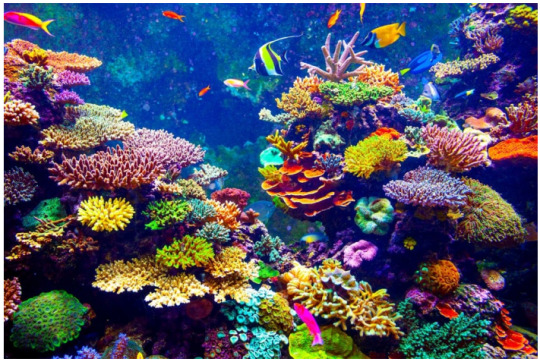
Credit: Gaby Pilson
In this blog, we will explore various shapes of corals and the factors determining coral morphology. We will also know how colourful corals acquire diverse colouration. Before getting to the main points, let's take a look at various beautiful corals below.

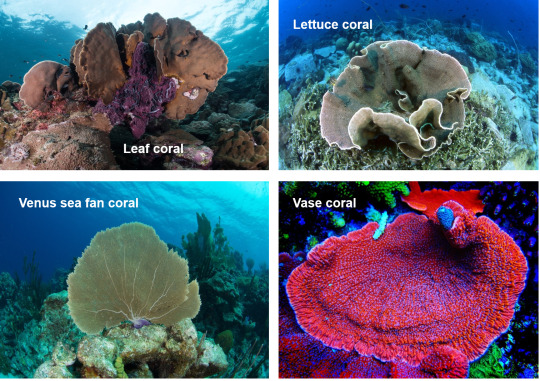
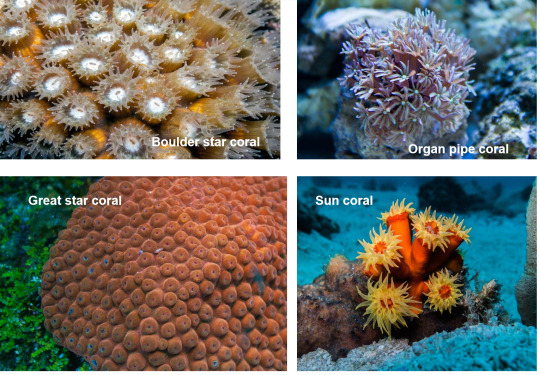
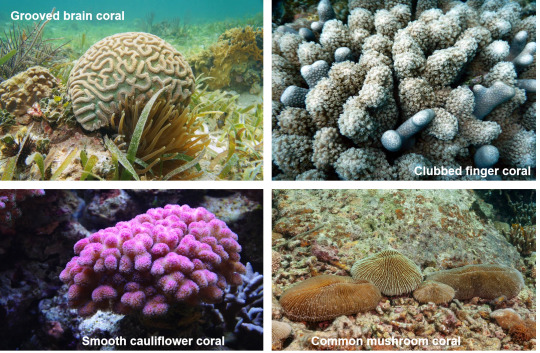


Credit: Gaby Pilson
Coral morphology
Within and among taxa, scleractinian corals vary in morphology, from the simple encrusting or hemispherical colonial shape to tree-like branching, bubble-like, finger-like or globular shapes (Zawada, Dornelas & Madin 2019).
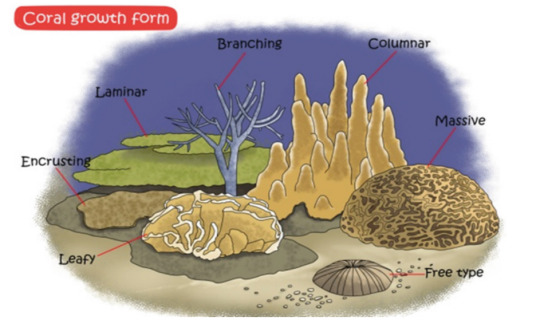
Credit: Liao, Xiao & Li
The variation and complexity in the morphology of corals can be affected by several factors, such as
environmental conditions (Zawada, Dornelas & Madin 2019)
biological process (Jackson 1979)
genetic constraints (Filatov et al. 2013)
partial mortality (Meesters, Wesseling & Bak 1996)
fragmentation of colony (Karlson 1986)
indeterminate growth (Sebens 1987)
The environmental conditions include free-flowing water for filter feeding and adequate sunlight for photosynthesis (Hoogenboom, Connolly & Anthony 2008; Kaandrop et al. 1996). Although most corals favour the mentioned environmental conditions, corals can also adapt to less optimal growing environments. Based on adaptability, various coral species' population density also differs in a particular environment.
For instance, platy and foliose corals are the dominant species in deeper water or shallow, sheltered, high-turbid and low-light areas (Riegl, Heine & Branch 1996; Hallock 2005). Other coral species also grow in such regions, but their population densities are relatively lower (Zapalski et al. 2021). These two corals are more adaptable to low light because the platy and foliose morphologies maximize the surface area to harvest light for photosynthesis (Anthony, Hoogenboom & Connolly 2005; Kahng et al. 2012).

Credit: Khao Lak Explorer
Some corals, such as the staghorn and elkhorn corals, grow upwards to reduce and avoid competition for the benthic space (Jackson 1997). The upward growth allows these corals not to need to continuously occupy the benthic space to increase their standing biomass.

Credit: Gaby Pilson
Some corals, such as laminar and foliose corals, grow laterally on the benthos to diversify the risk, thereby reducing the colony's mortality (Jackson 1979).

Credit: Khao Lak Explorer (Foliose coral); Project Noah (Laminar coral)
Coral colouration
Corals are colourful. But how do corals acquire diverse colour patterns and intensities? Well, the coral colouration is determined by (Dove et al. 2006; Oswald et al. 2007):
endosymbionts
fluorescent proteins
The symbiotic dinoflagellates living in the coral cells give a brown colour to the surfaces of corals (Porter et al. 1984). Depending on the densities of the cells or photosynthetic pigments, the brown colour may get paler or darker (Porter et al. 1984).
The fluorescent proteins (FPs) in coral cells mainly refer to the green fluorescent protein-like proteins that can fluoresces under the visible or ultraviolet light to produce colouration in corals, such as the brilliant green, red and blue (Dove, Hoegh-Guldberg & Ranganathan 2001). FPs are suggested to be photo-protective (Salih et al. 2000) or photo-enhancing (Schlichter, Meier & Fricke 1994). In the photo-protective role, FPs can dissipate excess energy by scattering light and fluorescing to prevent photo-damage and photo-inhibition in coral symbionts in excessive sunlight (Salih et al. 2000). In the photo-enhancing role, FPs can absorb light with a shorter wavelength and re-emit it with a wavelength suitable for the endosymbiont of corals to carry out photosynthesis (Frade et al. 2008).
That's all for this blog. Hope you enjoy the read ^ ^
References
Anthony, KR, Hoogenboom, MO & Connolly, SR 2005, ‘Adaptive variation in coral geometry and the optimization of internal colony light climates’, Functional Ecology, vol. 19, pp.17-26.
Dove, SG, Hoegh-Guldberg, O & Ranganathan, S 2001, ‘Major colour patterns of reef-building corals are due to a family of GFP-like proteins’, Coral Reefs, vol. 19, pp.197-204.
Dove, S, Ortiz, JC, Enríquez, S, Fine, M, Fisher, P, Iglesias-Prieto, R, Thornhill, D & Hoegh-Guldberg, O 2006, ‘Response of holosymbiont pigments from the scleractinian coral Montipora monasteriata to short‐term heat stress’, Limnology and Oceanography, vol. 51, no. 2, pp.1149-1158.
Filatov, MV, Frade, PR, Bak, RP, Vermeij, MJ & Kaandorp, JA 2013, ‘Comparison between colony morphology and molecular phylogeny in the Caribbean scleractinian coral genus Madracis’, PLoS One, vol. 8, no. 8, p.e71287.
Frade, PR, Englebert, N, Faria, J, Visser, PM & Bak, RPM 2008, ‘Distribution and photobiology of Symbiodinium types in different light environments for three colour morphs of the coral Madracis pharensis: Is there more to it than total irradiance?’, Coral Reefs, vol. 27, pp.913-925.
Hallock, P 2005, ‘Global change and modern coral reefs: New opportunities to understand shallow-water carbonate depositional processes’, Sedimentary Geology, vol. 175, pp.19-33.
Hoogenboom, MO, Connolly, SR & Anthony, KR 2008, ‘Interactions between morphological and physiological plasticity optimize energy acquisition in corals’, Ecology, vol. 89, no. 4, pp.1144-1154.
Jackson, JBC 1979, ‘Morphological strategies of sessile animals’, in G Larwood & BR Rosen (eds), Biology and Systematic of Colonial Animals, Academic Press, Google ebooks, pp. 499-555.
Kaandorp, JA, Lowe, CP, Frenkel, D & Sloot, PM 1996, ‘Effect of nutrient diffusion and flow on coral morphology’, Physical Review Letters, vol. 77, no. 11, p.2328.
Kahng, SE, Hochberg, EJ, Apprill, A, Wagner, D, Luck, DG, Perez, D & Bidigare, RR 2012, ‘Efficient light harvesting in deep-water zooxanthellate corals’, Marine Ecology Progress Series, vol. 455, pp.65-77.
Karlson, RH 1986, ‘Disturbance, colonial fragmentation, and size-dependent life history variation in two coral reef cnidarians’, Marine Ecology Progress Series, vol. 28, pp.245-249.
Meesters, EH, Wesseling, I & Bak, RP 1996, ‘Partial mortality in three species of reef-building corals and the relation with colony morphology’, Bulletin of Marine Science, vol. 58, no. 3, pp.838-852.
Oswald, F, Schmitt, F, Leutenegger, A, Ivanchenko, S, D'Angelo, C, Salih, A, Maslakova, S, Bulina, M, Schirmbeck, R, Nienhaus, GU & Matz, MV 2007, ‘Contributions of host and symbiont pigments to the coloration of reef corals’, The FEBS Journal, vol. 274, no. 4, pp.1102-1122.
Porter, JW, Muscatine, L, Dubinsky, Z & Falkowski, PG 1984, ‘Primary production and photoadaptation in light-and shade-adapted colonies of the symbiotic coral, Stylophora pistillata’, Proceedings of the Royal Society of London. Series B. Biological Sciences, vol. 222, no. 1227, pp.161-180.
Riegl, B, Heine, C & Branch, GM 1996, ‘Function of funnel-shaped coral growth in a high-sedimentation environment’, Marine Ecology Progress Series, vol. 145, pp.87-93.
Salih, A, Larkum, A, Cox, G, Kühl, M & Hoegh-Guldberg, O 2000, ‘Fluorescent pigments in corals are photoprotective’, Nature, vol. 408, no. 6814, pp.850-853.
Schlichter, D, Meier, U & Fricke, HW, 1994 ‘Improvement of photosynthesis in zooxanthellate corals by autofluorescent chromatophores’, Oecologia, vol. 99, pp.124-131.
Sebens, KP 1987, ‘The ecology of indeterminate growth in animals’, Annual Review of Ecology and Systematics, vol. 18, pp.371-407.
Zapalski, MK, Baird, AH, Bridge, T, Jakubowicz, M & Daniell, J 2021, ‘Unusual shallow water Devonian coral community from Queensland and its recent analogues from the inshore Great Barrier Reef’, Coral Reefs, vol. 40, pp.417-431.
Zawada, KJ, Dornelas, M & Madin, JS 2019, ‘Quantifying coral morphology’, Coral Reefs, vol. 38, no. 6, pp.1281-1292.
Images or videos from external sources:
Gaby Pilson - https://outforia.com/types-of-coral/
Khao Lak Explorer - https://www.khaolakexplorer.com/coral-types/
Liao, Xiao & Li - https://link.springer.com/chapter/10.1007/978-94-024-1612-1_1
Project Noah - https://www.projectnoah.org/spottings/6319210
0 notes
Text
Marine "Rainforest" - Coral Reefs

Credit: Shaun Low
Introduction
I am Crystal, on a journey to explore mysterious and magical tropical ecology. The theme of my blog is about coral reefs. I choose this because people always say they are important; they are dying now; we must save them. This raises my curiosity to know more about coral reefs. In the exploration of coral reefs, I will share and divide my findings into five entries as follows:
First entry
formation of coral reefs
growing environments
Second entry
Diverse shapes and types of corals
Factors affecting the conformations of corals
Third entry
Feeding behaviour of corals
Reproduction mechanisms
Fourth entry
Ecological relationship between coral reefs and other marine creatures (describe using examples)
Fifth entry
Significance of coral reefs in tropical marine ecosystem
Now, you roughly know what I am going to say about coral reefs. So, let us move on to the first entry.
Coral reefs - Animals or plants?

Credit: Created using Canva
When you dive into the ocean, you are surprised by the beautiful and gorgeous scene at the seabed - the colourful coral reefs. When first looking at corals, you will immediately think they are beautiful plants. Yes, they look very similar to plants but are actually animals. Corals are coelenterates (Goreau, Goreau & Goreau 1979). The phylum's name comes from the Greek words koilos (hollow) and enteron (gut), so corals are hollow guts because their main and long body cavity is the digestive tract (Goreau, Goreau & Goreau 1979).
From corals to coral reefs
Corals are simple and multicellular animals. But how do they grow into the extensive coral reefs we usually find in the ocean? The living, carbonate coral reef system is established from the symbiotic relationship between the reef-building corals and plant-like dinoflagellates (Hoegh-Guldberg 2011). Dinoflagellates are unicellular organism that lives inside the gastrodermal cells of reef-building corals in the order Sclerantinia in the Class Anthozoa and the Phylum Cnidaria (Hoegh-Guldberg 2011). Dinoflagellates are called plant-like because they can perform the unique skill of plants - photosynthesis. In the corals’ gastrodermal cells, dinoflagellates provide a lot of energy from photosynthesis to the coral host (Hoegh-Guldberg 2011). In return, the corals feed dinoflagellates with the metabolized inorganic nutrients, which their quantity is very low in the clear tropical and subtropical marine water (Muscatine et al. 2005).

Credit: Kudela lab group
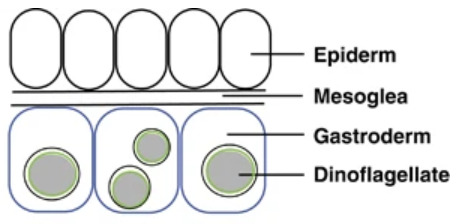
Credit: Pernice et al.
Fastidious coral reefs
Coral reefs are very picky to the growing environments. They only like ocean water that is sunlit, clear and warm (Goreau, Goreau & Goreau 1979). In addition, they only grow in shallow marine sites at a depth below 100 m and in regions within 30˚ north or south of the equator (Hoegh-Guldberg 2011) because their photosynthetic symbiont requires abundant sunlight. They need clear ocean water because the turbidity can inhibit light penetration (Hoegh-Guldberg 2011). The ocean temperature should be stable and warm (Kleypas et al. 1999). For instance, the ocean temperature cannot fall below 18˚C in places with winter (Kleypas et al. 1999). The growing sites should also contain splendid carbonate ions, which are critical to the calcification of corals (Hoegh-Guldberg 2011). Collectively, coral reefs mainly thrive in shallow equatorial coastal regions because these areas are typically sunlit, warm and supersaturated with carbonate ions.

Credit: Created using Canva
Now, you have an idea of how coral reefs form and what types of environments they like. I have found a nice video that briefly introduces coral reefs. Feel free to watch it if you are interested ^^
youtube
Credit: National Geographic
References
Goreau, TF, Goreau, NI & Goreau, TJ 1979, ‘Corals and coral reefs’, Scientific American, vol. 241, no. 2, pp.124-137.
Hoegh-Guldberg, O 1999, ‘Climate change, coral bleaching and the future of the world's coral reefs’, Marine and freshwater research, vol. 50, no. 8, pp. 839-866.
Hoegh-Guldberg, O 2011, ‘Coral reef ecosystems and anthropogenic climate change’, Regional Environmental Change, vol. 11, pp. 215-227.
Kleypas, JA, Buddemeier, RW, Archer, D, Gattuso, JP, Langdon, C & Opdyke, BN 1999, ‘Geochemical consequences of increased atmospheric carbon dioxide on coral reefs’, Science, vol. 284, no. 5411, pp. 118-120.
Muscatine, L, Goiran, C, Lynton, L, Jaubert, J, Cuif, JP & Allemand, D 2005, ‘Stable isotopes (δ13C and δ15N) of organic matrix from coral skeleton’, Proceedings of the National Academy of Sciences, vol. 102, no. 5, pp. 1525-1530.
Reaka-Kudla, ML 1997, ‘The global biodiversity of coral reefs: a comparison with rain forests’, in ML Reaka-Kudla, DE Wilson & EO Wilson (eds), Biodiversity II: Understanding and Protecting Our Biological Resources, pp. 83-108.
Images or videos from external sources:
Kudela lab group - http://oceandatacenter.ucsc.edu/PhytoGallery/dinos%20vs%20diatoms.html
National Geographic - https://youtu.be/ZiULxLLP32s
Pernice et al. - https://www.nature.com/articles/ismej2011196#Fig1
Shaun Low - https://unsplash.com/photos/v8Un2Roo1Ak
3 notes
·
View notes